
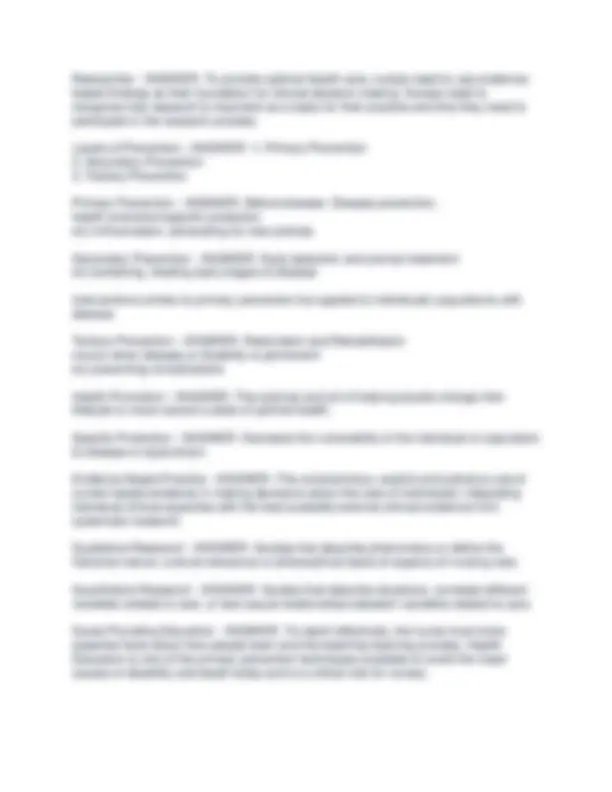
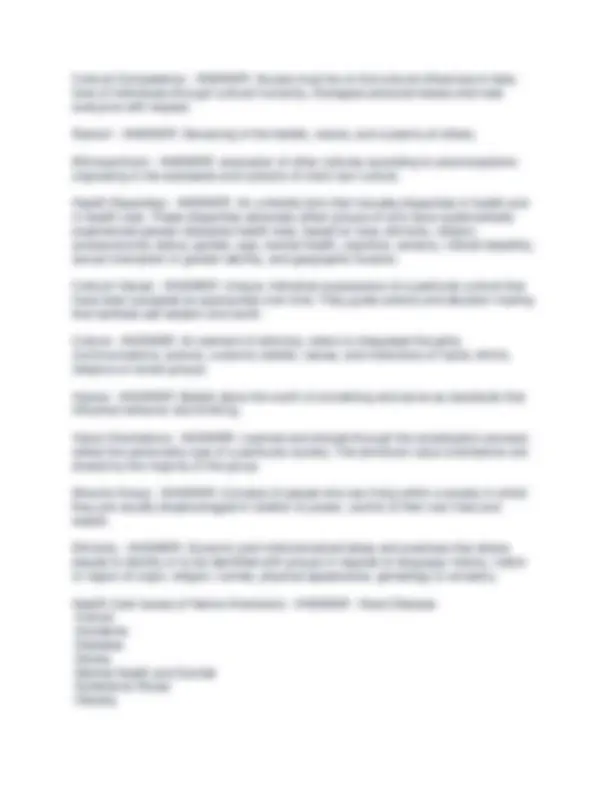
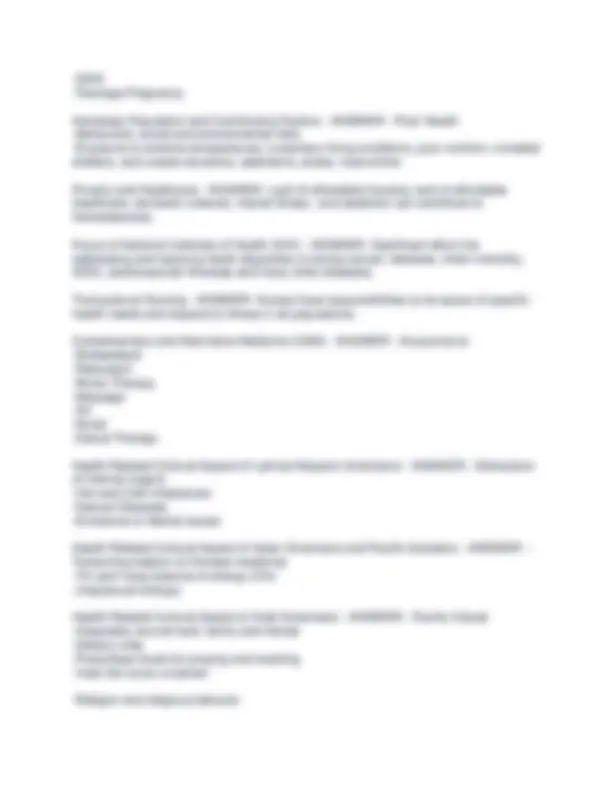
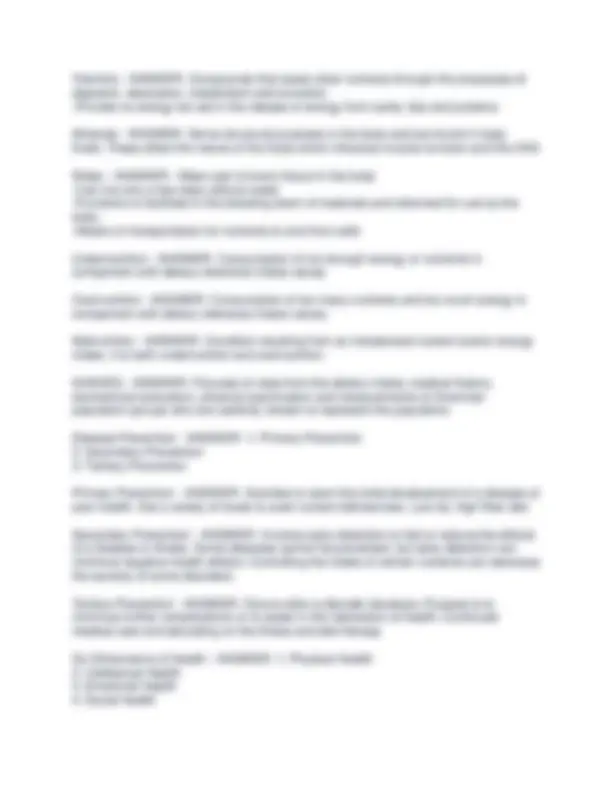
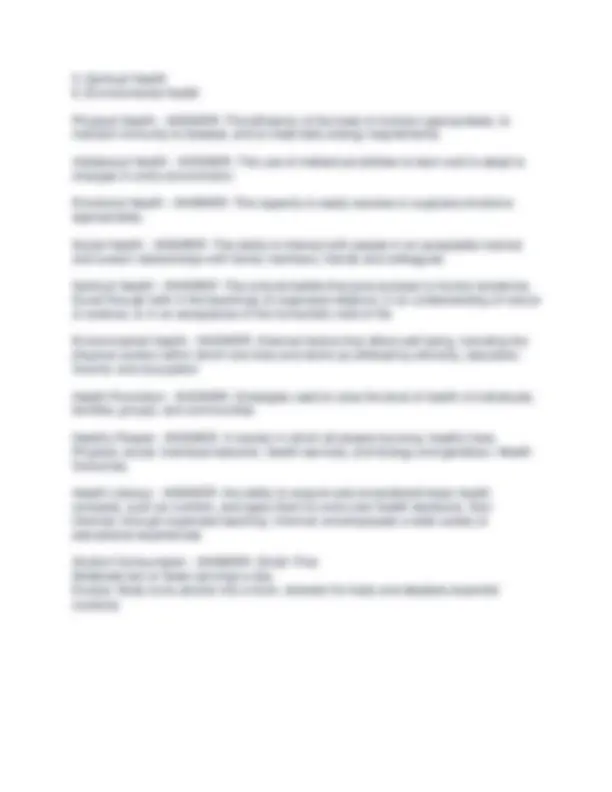



Study with the several resources on Docsity

Earn points by helping other students or get them with a premium plan


Prepare for your exams
Study with the several resources on Docsity

Earn points to download
Earn points by helping other students or get them with a premium plan
Community
Ask the community for help and clear up your study doubts
Discover the best universities in your country according to Docsity users
Free resources
Download our free guides on studying techniques, anxiety management strategies, and thesis advice from Docsity tutors
A comprehensive set of questions and answers related to key concepts in nursing, including health models, levels of prevention, cultural competence, and health disparities. It covers topics such as the clinical model, role performance model, adaptive model, and eudaemonistic model of health, as well as primary, secondary, and tertiary prevention. The document also explores cultural values, health care issues of native americans, and the homeless population. It is a valuable resource for nursing students preparing for exams or seeking a deeper understanding of these fundamental concepts.
Typology: Exams
1 / 10

This page cannot be seen from the preview
Don't miss anything!







Values and beliefs pattern - ANSWER- Values, beliefs or goals that guide choices or decisions Smith (1983) describes four distinct models of health in her classic work: - ANSWER- Clinical model Role performance Adaptive Model Eudaemonistic Model Clinical Model - ANSWER- Health is defined by the absence and illness of disease. With this model, people may wait to seek healthcare until they are sick. They often don't seek preventative healthcare. Role performance Model - ANSWER- Health is defined in terms of individuals' ability to perform social roles. In this model, you are sick when you can't function in your role (i.e., need to miss school or work). Adaptive Model - ANSWER- People's ability to adjust positively to social, mental, and physiological change is the measure of their health. In this model a person gets sick when he fails to adapt to change. Eudaimonistic Model - ANSWER- embodies the interaction and interrelationships among physical, social, psychological, and spiritual aspects of life and the environment in goal attainment and creating meaning in life. Those who believe in this model often look for alternative providers of care. (e.g., a person has a primary care provider and someone he sees for acupuncture.) Wellness - ANSWER- A positive state in which incremental increases in health can be made beyond the midpoint. These increases involve improved physical and mental health states. Health - ANSWER- A state of physical, mental, spiritual, and social functioning that realizes a person's potential and is experienced within a development context. Illness - ANSWER- Composed of the subjective experience of the individual and the physical manifestation of disease. People are in an imbalanced, unsustainable relationship with their environment and are failing in their ability to survive and create a higher quality of life.
Goals of Healthy People - ANSWER- 1. Attain high quality, longer lives free of preventable disease, disability, injury and premature death
Cultural Competence - ANSWER- Nurses must be on the cultural influences in daily lives of individuals through cultural humanity. Disregard personal biases and treat everyone with respect. Racism - ANSWER- Devaluing of the beliefs, values, and customs of others. Ethnocentrism - ANSWER- evaluation of other cultures according to preconceptions originating in the standards and customs of one's own culture. Health Disparities - ANSWER- An umbrella term that includes disparities in health and in health care. These disparities adversely affect groups of who have systematically experienced greater obstacles health wise, based on race, ethnicity, religion, socioeconomic status, gender, age, mental health, cognitive, sensory, mental disability, sexual orientation or gender identity, and geographic location. Cultural Values - ANSWER- Unique, individual expressions of a particular culture that have been accepted as appropriate over time. They guide actions and decision-making that facilitate self esteem and worth. Culture - ANSWER- An element of ethnicity, refers to integrated thoughts, communications, actions, customs, beliefs, values, and institutions of racial, ethnic, religious or social groups. Values - ANSWER- Beliefs about the worth of something and serve as standards that influence behavior and thinking. Value Orientations - ANSWER- Learned and shared through the socialization process, reflect the personality type of a particular society. The dominant value orientations are shared by the majority of the group Minority Group - ANSWER- Consists of people who are living within a society in which they are usually disadvantaged in relation to power, control of their own lives and wealth. Ethnicity - ANSWER- Dynamic and institutionalized ideas and practices that allows people to identify or to be identified with groups in regards to language, history, nation or region of origin, religion, names, physical appearance, genealogy or ancestry. Health Care Issues of Native Americans - ANSWER- - Heart Disease
former generations contribute to individuals' health behavior. Nurses provide this when they identify and use cultural norms, values, and communication and time patterns. Estimated Average Requirement (EAR) - ANSWER- Amount of nutrient needed to meet the basic requirements of half the individuals in a specific group that represents the population. Used to determine the basis for setting RDA's Recommended Dietary Allowance (RDA) - ANSWER- Level of nutrient intake sufficient to meet the needs of almost all healthy individuals of a life-stage and gender group. Some nutrients have not an RDA but an AI. Adequate Intake (AI) - ANSWER- The approximate level of an average nutrient intake determined by the observation of or experimentation with a particular group. Used when insufficient data to set an RDA Tolerable Upper Intake Level (UL) - ANSWER- Level of nutrient intake that should not be exceeded to prevent adverse health risks. Includes total consumption of foods, fortified foods and supplements. Acceptable Macronutrient Distribution Ranges (AMDLs) - ANSWER- Daily percentage intake values for the macronutrients fat,, carbohydrate, and protein
Vitamins - ANSWER- Compounds that assist other nutrients through the processes of digestion, absorption, metabolism and excretion.